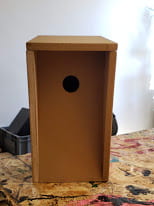My clinical assignment for this week is psychiatric and mental health within the Bydel St. Hanshaugen district. Today I had the opportunity to work with a program they call “Flexible”. In this program there are several types of professionals, including nurses and social workers, who help Norwegians who have a severe mental illness and a history of violence due to their mental illness. Because these patients have severe mental illness issues, they are unable to hold a job. These patients are, however, able to live independently in city owned apartment flats, which are scattered throughout the district, and the patients live among the general population, with the theory that allowing the patients to live in a normal environment is good for their mental health. Many of the patients have been institutionalized and/or imprisoned previously – they are known within the healthcare and law enforcement communities. The patients must sign contracts with the Flexible program; these contracts include the agreement to receive an intramuscular injection once every two weeks which contains an extended release antipsychotic medication (the specific medication depends on their illness), and the Flexible program also keeps a copy of their apartment key in case they need to get the door open to check on the patient during their weekly visit. All patients in the program are known to have a substance abuse problem (amphetamines are the most commonly used street drug in Norway). Interestingly, patients are not required to stop substance abuse to be a part of this program. Recreational drug use is illegal in Norway, however, it is not common for a person to go to prison for using drugs, and if they are in the Flexible program drug use will be tolerated as long as they continue to abide by the contract.
One aspect of the Flexible program is the program tries to connect patients to resources to utilize skills they already have and to do things they enjoy doing. The activity I got to help with today was a bird and bat house project. There is a skills program offered to Norwegians who do not complete high school and one of the skills taught is wood working. These students in the skills program build wooden bird houses and bat houses which are then given to the Flexible program. The patients in the Flexible program often enjoy artistic activities. The patients paint the houses, which are then taken out in to the community and hung up for birds and bats. The patients enjoy the activity, and it makes them feel good that they contributed something valuable to society. This project not only benefits Norway, but also impacts healthcare goals on a global scale. In 2015 the UN introduced 17 Sustainable Development Goals (SDG’s), with the mission to improve lives for everyone on this planet and to help take care of our Earth. The bird and bat house project contributes toward multiple goals – Goal 3 Good Health and Well-Being, Goal 8 Decent Work and Economic Growth, Goal 10 Reduced Inequalities, and Goal 11 Sustainable Cities and Communities (SDGs, n.d.). More information about SDGs can be found here: https://sustainabledevelopment.un.org/sdgs. In addition to meeting the SDGs, the Flexible program and projects that it sponsors also meets the Public Health Core Competencies set forth by the The Council on Linkages Between Academia and Public Health Practice. As a Tier 1 program, they contribute to competency 5A6, Engaging Community Members as part of the Community Dimensions of Practice Skills Core Competency (Core competencies for public health professionals, 2014). By offering activities like the bird and bat house project, the Flexible program engages their patients to improve health within their community. More information about Core Competencies for Public Health Professionals, visit: http://www.phf.org/resourcestools/Documents/Core_Competencies_for_Public_Health_Professionals_2014June.pdf.
My experience with the Flexible program will certainly have an influence on the way I practice nursing care and, in the future, as I become an NP. One of the program workers was explaining to me a patient who hasn’t been opening up to their counselor during therapy sessions may find a level of comfort with the Flexible workers as they paint and have a casual conversation, which then allows that patient to begin to open up and share what they are experiencing or going through, providing valuable information and insight into the patient’s progress.
References:
Core competencies for public health professionals. (2014, June 26). Retrieved May 28, 2019, from http://www.phf.org/resourcestools/pages/core_public_health_competencies.aspx
SDGs: Sustainable Development Knowledge Platform. (n.d.). Retrieved May 28, 2019, from https://sustainabledevelopment.un.org/sdgs


